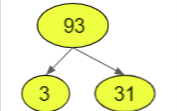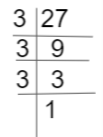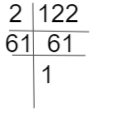Prime Factorization is a process of factoring in a number into its prime numbers that is the factors will be Prime Numbers. A prime number could be a number that has only two factors, i.e. 1 and the number itself. Here, we will discuss the concept of Prime Factorization, different methods of Prime Factorization, how to find the prime factorization of given numbers, some solved example problems, and so on which will help the students to understand the concept easily and used it for better practice.
The easy and quick processing method is to find the prime factorization of any given number is to stay on dividing the initial number by prime factors until the remainder is adequate to 1. Consider an example, the prime factor of number 10 we get, 10/2 = 5, 5/5 = 1. So, we get the remainder as 1 and it cannot be used for further factorization. Therefore, 10 = 2 x 5, where 2 and 5 are prime factors.
Also, Read Some Articles:
Prime Factorization – Definition
Prime Factorization is defined as a method of finding the prime factors of two or more numbers, such that the original number is divisible by these factors. We know, the composite number has more than two factors. Therefore, this method is simply applicable to composite numbers and not for prime numbers.
The prime numbers when multiplied by the other natural numbers or whole numbers except 0, will give composite numbers. So generally the prime factorization is performed on composite numbers to factorize them and find their prime factors. This method is additionally accustomed for finding the Highest Common Factors (HCF) and Least Common Factors (LCM ) of any given set of numbers.
If any two numbers are given, then the highest common divisor is that the most important factor is present in both the numbers whereas the least integer is that the smallest whole number of both the numbers.
Example: Find the Prime Factorization of 24.
Solution: Given value is 24.
Using Prime factorization,
The Prime factors 24 is 2 x 2 x 2 x 3 = 24
The numbers 2, 3 are prime numbers.
The factors of 24 are 2, 3.
Hence, the Prime Factorization of 24 is 2 x 2 x 2 x 3.
How to do Prime Factorization?
For finding the given number prime factorization, we’ve two methods. The 2 methods are,
(i) Division Method
(ii) Factor Tree Method
(i) Division Method:
In this method, we keep it up by dividing numbers until the quotient becomes 1. To calculate the prime factors of a given number is comparable to the method of finding the factors of a large number. The subsequent steps are to find the prime factors of a given number using the Division Method.
Step 1: Initially, divide the given number by the least prime number. The smallest number should be divided the number exactly.
Step 2: Next, divide the quotient by the least prime number.
Step 3: Repeat this process, until the quotient value becomes 1.
Step 4: Finally, multiply all the prime factors to induce the initial number.
Example: Find the Prime Factorization of 48 using Division Method?
Solution: As given in the question, the value is 48.
Using Divison Method find the Prime Factors.
Dividing 47 by least prime number.
48 ÷ 3 = 16
Again divide 16 by 4,
16 ÷ 4= 4
Divide 4 by 4,
4÷ 4 = 1
Now, we got a quotient of 1. So, no further division is possible.
Therefore, the Prime Factorization of 48 is 3 x 4 x 4.
(ii) Factor Tree Method :
In this factor tree method, the number factors are formed, and those numbers are again factorized until no further division is possible. To follow the below steps to find the prime factorization of the given number using the factor tree method.
Step 1: Consider the given number is the base of the tree.
Step 2: Write down the pair of factors within the branches sort of a tree.
Step 3: Again factorize the composite factors, and write down the factors pairs within the branch sort of the tree.
Step 4: Repeat the step, until you have got found the prime factors of all the composite factors.
Example: Find the Prime Factorization of 80 Using Factor Tree Method.
Solution: Given the number, using the Factor tree method find the prime factors.

Therefore, the Prime Factors of 80 is 2 x 2 x 2 x 2 x 5
Prime Factorization Examples
Example 1:
Find the Prime Factorization of 93 using the Factor Tree Method.
Solution:
Given the number is 93.
Using the Factor Tree Method, the way to find the factors is shown below,

Therefore, the factors of 93 are 3 x 31.
Example 2:
What is the Prime Factorization of 27? Find using the Division Method?
Solution:
As given within the question,
Now, we are going to find the prime factors of 24 using the division method.

Thus, the Prime factorization of 24 is 3 x 3 x 3.
Example 3:
Find the Prime Factorization of 70?
Solution:
Given the number,
First, divide the number 70 using the smallest prime number that is 2.
70÷3 =35
Next, divide the quotient with the other least prime number.
35÷ 5= 7
Now, again divide that quotient with the smallest prime number.
7÷7 =1
Hence, 7 may be a prime number the division process ends here.
The Prime Factors of 35 are 2, 3, 7.
Example 4:
Find the Prime Factorization of 105?
Solution:
Given the value,
Note down top the number 105 because of the root of the tree structure. Firstly, find the factors of 105 and write down them as branches. Since 35 will be further expressed as factor pairs of 5 and seven (7). Continue the method till the numbers are all prime. Below the Factor, Tree Structure is made for number 105.

Example 5:
Find the Prime Factorization of 122?
Solution:
As given within the question, the value is 122.

Above is that the figure step-by-step process of prime factorization of 122 using the division method.
Step 1: Divide 122 with the smallest prime number 2.
122÷2 = 61
Step 2: Next divide the quotient with the least prime factor but any number doesn’t divide on 61. Only 61 and 1 are going to be divided.
As 61 is that the prime number that has factors 1 and itself.
Now, the prime factorization of 122 is expressed as 2*61.
FAQ’s on Prime Factorization
1. Define Prime Factorization.
Prime factorization is that the process of finding prime numbers. After we multiply together these prime factors we’ll get the initial number. As an example, the prime factors of 8 are 2 x 2 x 2, Which may even be also be written as 2³.
2. Define Factor Tree?
A factor tree could be a diagram sort of a tree structure accustomed to determine the prime factors of a natural number. It is one of the methods to find the prime factorization of any given number.
3. What are the different methods to find the prime factors of a number?
There are two different methods to find the prime factors of a number namely as:
1. Division method
2. Factor tree method
4. What are the Prime Factors of 16?
Prime Factors of 12 are 2, 2, 4, and that we can express it as 2*2*4.
